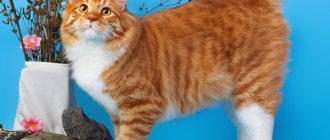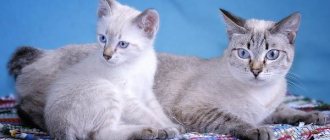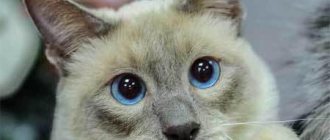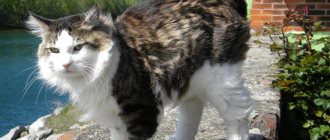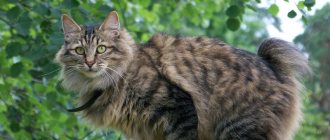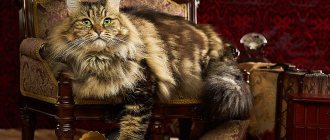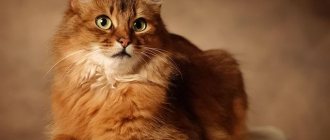Origin story
Among the ancestors of the Kuril Bobtail are the famous Japanese Bobtail: stately and strong cats with the same short tails and a “dancing” gait. The Japanese kept these animals in temples and revered them as sacred objects, but the craving for a free life often took precedence over their usual comfort, and the cats ran away into the wild.
Once on the Kuril Islands, Japanese bobtails began to change noticeably: the cats increased in size, their coat color changed, and their claws stopped retracting inward. And over time, when Russian settlers brought their favorites to the islands - wonderful fluffy Siberian cats - they became friends with them.
As a result of the mixing of blood, the modern Kurilian Bobtail was born - an outstandingly sized cat with thick dense hair and a funny pom-pom tail. Their amazing agility, unfailing hunting instinct and good health captivated people and in the late 80s, cat lovers started talking about them as a full-fledged breed. The first standard was adopted by the Soviet Felinological Federation in 1991, the general one (WCF) - in 1995.
Today it is not difficult to buy a Kurilian Bobtail kitten. There are quite a lot of nurseries operating in Russia, and there is no shortage of private breeders. The cost depends not only on the appearance, but also on the titles of the parents, the conditions of keeping and raising the animal. The price tag starts from 20,000 rubles. Taking an animal from your hands and without documents is fraught with problems in the future.
Breed characteristics
Is it difficult to care for smokers? | This is an easy breed to care for. There are no particular difficulties. But it is important to properly organize her nutrition. |
Are Kurilian Bobtails wild cats? | This is an aboriginal breed originally from the Kuril Islands. Her relatives still live on the archipelago. But not in the forests, but in the houses of local residents. |
Why do Kuril Islands have short tails? Are they docked? | Cats of this breed are born with short tails. They are not docked. |
Is a stubby tail a developmental defect? | A short tail is not a defect, but a naturally expressed genetic trait, a breed-forming trait. |
They say that Kurilian Bobtails do not shed. This is true? | They shed their hair much less often than cats of other breeds. The fur sheds a lot when kittens take off their baby clothes. During other periods, molting is less noticeable. |
Is it true that smokers do not cause allergies? | They cannot be called hypoallergenic. They shed less, but allergies are most often caused not by fur, but by an antigen secreted by cats along with saliva. |
They say that cats of this breed do not mark territory. This is true? | Bobtails do not spray urine. But unneutered cats find other ways to check in. They scratch walls and furniture and leave puddles on the floor. Sexual abstinence can also result in health problems. If you do not plan to use the animal for breeding, it is better to castrate it. |
Do Kurils have a Siamese cat color? | This color is prohibited by current standards. The colorpoint (Siamese) color for this breed is a waste. Such animals are excluded from breeding and castrated. |
Where is the best place to keep them? | Adapt to life in any house or apartment. |
How do they cope with heat and cold? | Snow and frost are a familiar environment for them. They tolerate cold and moderate heat well, just like their ancestors. |
Does the smoke really have no smell? | Yes, they really don't smell. The ancestors of this breed are active hunters. The scent during a hunt would alert prey to the approach of predators. |
Do I need to go for a walk? | The breed is active. Pets will be happy to frolic in nature both in summer and winter. |
How picky are they when it comes to food? | There are no special problems with food. But they should not be given dairy products. |
Do I need to bathe? | Most pets react calmly to water. They are easy to bathe. But don't be overzealous. Water procedures are carried out only as needed. |
How to care for your tail? | The unusually shaped ponytail does not require special care and attention. |
Is it possible to cross Kurils with other breeds? | Such matings are prohibited. Animals imported from the Kuril Islands require proof of importation to participate in the novice class at shows. |
What difficulties arise in breeding? | Cats are not very fertile. They have one litter per year (an ordinary domestic cat may have 4 or 5). |
How do smokers behave in the house? | Pets love to play. For them you need to arrange a corner with climbing frames and ladders. |
Attitude towards children and other family members | They become attached to one person. They behave friendly with children and other family members. Good companions. They can be security guards. |
Attitude towards other animals | In the wild they live in packs, so in the apartment they like to be in the company of their relatives. They can be friends with dogs. They prefer large dogs. |
How long do Kurilian Bobtails live? | As a naturally occurring breed, these are strong and healthy cats that live up to 20 years. |
Advantages of the breed
- They combine the independence and charm of a wild animal with the extraordinary devotion of a domestic cat.
- An amazing pom-pom tail for cats, which is individual for each individual.
- They are easy to care for.
- Learning ability and high intelligence.
- They are trainable and quickly learn commands.
- Their cleanliness is excellent; they quickly get used to the tray.
- If you arrange a corner for your smoker to play, he will not damage the furniture with his claws.
- Males of this breed take on the same responsibility for their offspring as females.
- The best jumpers among cats.
- Good swimmers by nature. As a rule, they love water.
- The Kuriles are the greatest masters of survival.
- Excellent mousecatchers and fishermen.
- They can withstand the road better than other domestic cats;
- Well suited for families with children or people with dogs.
Disadvantages of the breed
- These are real children of nature. In childhood they are characterized by curiosity. They do not like closed doors and try to fight this obstacle in the ways available to them.
- The character is strong and strong-willed, especially in wild-colored individuals. According to the observations of breeders, they are the most independent and willful.
- The cat should not be allowed to decide that he is the boss of the house. Otherwise, he will mark his territory and cause mischief.
- Very dependent on people, strongly attached to the owner. She can follow him around and suffer in his absence.
- Can show aggression towards those who, in his opinion, threaten his beloved owner.
- You need to be careful with nutrition. It is not advisable to combine ready-made diets and natural feeding.
- High price. Show class kittens are expensive.
Standards
| Standard | Description |
| Eyes | Rough, large and expressive. The iris can be any (snow-white cats have both blue and multi-colored eyes). |
| Head | Large, with smooth, rounded contours, wedge-shaped. The ears are small, with a wide base and rounded tips. They are slightly inclined forward and are equipped with tassels like those of a lynx. The whisker pads are plump and well expressed. The nose is of medium size, wide, level and straight. The chin is clearly defined, massive, with rounded edges. |
| Torso | The body is powerful, long, with developed muscles and strong bones. The hips are raised, the chest is wide. The limbs are not short, but they cannot be called long either. Powerful and strong. Paws are oval, large, spread out. |
| Tail | The tail is a distinctive feature of the Kurilian Bobtail. Outwardly it looks like a soft fluffy pompom. The length can be different: in cats with semi-long hair - 11-13 cm, with short hair - 1.5-8 cm. There is an undercoat, but it is quite small. |
| Wool | The coat can be semi-long or short. Bobtails with short hair have the same length all over their body. Cats with semi-long hair always have a fluffy collar, “pants” on the hind legs, socks and a plume on the tail. |
Felinologists distinguish 4 types of tails:
- Longest: includes 5-7 vertebrae. At first they form a straight line, and then twist into a loop. But such a tail is considered a serious drawback.
- Tail-broom: here there can be even more vertebrae - 8 or even 10. But the tail remains straight.
- Spiral tail: Also 5-10 vertebrae forming a small hook or spiral.
- The last and shortest tail is a stump. Consists of a minimum of 2 and a maximum of 8 vertebrae that are seriously deformed.
Weight table by month
The weight of an adult Kuril Bobtail reaches 4-7 kg, in cats - 5-9 kg.
| Age | Cat | Cat |
| 1 month | 280-400 gr | 330-460 gr |
| 2 | 550-750 gr | 880-1.2 kg |
| 3 | 1-1.2 kg | 1.1-2.2 kg |
| 4 | 1.3-2.4 kg | 1.8-3.2 |
| 5 | 1.7-2.7 kg | 2.6-3.6 |
| 6 | 2.6-3.4 kg | 3-4.4 kg |
| 8 | 3-4.1 kg | 4-5.2 kg |
| 10 | 3.2-4.4 kg | 4.4-5.8 kg |
| 1 year | 3.5-5 kg | 5-6.8 kg |
| 2 | 3.8-6 kg | 5.4-6.6 kg |
Choosing a kitten
Even before going to the breeder, you need to decide what kind of kitten you need: a pet, a show star or a stud? Then you need to decide what gender the animal should be. Toys, a tray with filling and a supply of food for the first time must be prepared in advance.
You can go to the “browse” when the kittens are 5 weeks old. But it is not recommended to take a baby into the home under 8 weeks of age. At the breeder, pay attention to the conditions of detention. There should be no strong smell of urine, dirty bowls or overcrowding of animals.
The kitten must be:
- active, playful;
- not cowardly, curious and sociable;
- eyes and nose are dry, without discharge;
- the anus is not inflamed, without traces of feces;
- the stomach is soft, not bloated;
- the coat is clean and shiny.
The normal weight of a kitten at 2 months of age is 1 – 1.5 kg. He should not look emaciated or, on the contrary, too large.
Colors
Colors are varied, but certain colors are prohibited in most show systems: fawn, lilac, chocolate, cinnamon, acromelanic (Tonky, Siamese and Burmese) and ticked colors.
The amber color was discovered only recently and has not yet been included in the general standard.
Acceptable colors:
- Tortoiseshell and solid (black, red, cream, blue, white);
- Tabby;
- Marble (red, black, blue, cream, tortoiseshell);
- Brindle (black, red, tortoiseshell, cream, blue);
- Spotted (red, black, blue, cream, tortoiseshell);
- Harlequin (including marble);
- Bicolor;
- Wang;
- With white spots.
In the photo there are cats of the Kuril Bobtail breed of popular colors: black, white, tortoiseshell
Potential Health Problems
Representatives of the breed inherited excellent immunity from their ancestors living in Siberia. Kurilian Bobtails have excellent health, but there are a number of diseases to which pets are vulnerable:
- haemorrhoids;
- rectal prolapse;
- cracks and inflammation of the anal mucosa;
- urolithiasis disease.
Important! The best disease prevention is a timely visit to the veterinarian.
Character and behavior
The Kurilian Bobtail is often compared to a dog, which is not surprising: in devotion to humans, this cat breed rivals all those you know. These cats are calm, affectionate and gentle creatures who, however, can quite stand up for themselves. People are adored and immediately upon arriving in a new home, they choose a leader, whom I will follow through thick and thin.
Your movements around the apartment will not go unnoticed: bobtails will follow you on your heels, trying to show you their devotion and readiness to help in business. Even if such obsession annoys you, you will have to come to terms with it: bobtails have curiosity and a desire to be in company until they are very old.
He gets along with other pets without problems, but this applies exclusively to dogs and cats. Small animals (birds, hamsters, rats, chinchillas) are potential prey for bobtails, which they will chase until they catch them.
Other family members are potential friends for the bobtail. Cats treat children very kindly, carefully and patiently. They will not allow themselves to let out their claws or bite a child, so do not worry about leaving your Kurilian Bobtail and your toddler alone.
What does this pose mean in cats: crouching to the ground, arching their back, starting a mournful song?
Mating gamesPreparing for a fight
Attitude towards other animals
If other animals already live in the family, the bobtail will easily find a common language with them. He is equally welcoming to both cats and dogs, so it will not be difficult for him to establish contact with a mischievous dachshund and a formidable Maine Coon.
However, it is worth noting that the presented breeds categorically cannot tolerate ornamental birds and rodents. This is due to the developed hunting instinct.
Care instructions
Wool
The Kurilian Bobtail's coat does not tangle and is not prone to tangles, so you should not brush them more than 1-2 times a week. These cats simply love to swim (by the way, Kurilian Bobtails are not only good hunters, but also excellent fishermen), so bathe them once every 1-2 months.
Claws
They get accustomed to the scratching post quickly and do not need additional nail trimming.
Eyes
But you need to watch your eyes and ears. Both are wiped with a damp cotton pad soaked in hydrogen peroxide, tea leaves or chlorhexidine.
Teeth
Teeth are brushed 2-4 times a week using a special toothbrush with soft bristles and cat toothpaste (Bars, Doctor ZOO).
In the photo there are cats of the Kuril Bobtail breed: short-haired and semi-long-haired
Catering
High-quality food for the Kuril Bobtail is the key to a long and healthy life. So remember:
- An adult animal is fed 2 times a day: in the mornings and evenings. You should wash the bowls once a day (do not use any detergents other than laundry soap) and pour clean water at a comfortable temperature into the drinking bowl every day. Kittens 2-5 months old are fed 3-6 times.
- Don't feed your cat from your table. Fatty soups, fried potatoes, chocolate and other favorite foods, unfortunately, are real poison for the animal. Sweet, salty, smoked, sour, canned, flour and baked goods are strictly prohibited.
Natural products
Important diet foods:
- Meat (beef, chicken, turkey, rabbit).
- Fish (both river and sea).
- Plant foods (zucchini, pumpkin, carrots, green salad, asparagus, broccoli, parsley, dill, beans).
- Chicken yolk (boiled), quail eggs.
- Porridge (rice, oatmeal, buckwheat, millet).
- By-products (liver, kidneys, ventricles, hearts).
- Dairy products cause metabolic disruption. The same applies to potatoes, baked goods, dog food, and human canned food. But sprouted oat grains for bobtails are one of their favorite treats.
The water should either be passed through a kitchen filter or left for a day in an open container.
Recommended food
When choosing dry food, buy only food from the holistic group. Applaws, Farmina N&D, Jaguar. Other foods are not suitable for Kurilian Bobtails.
Below are the recommended holistic class foods. Links with the names of the food are clickable, on them you can, within our website, get acquainted with the descriptions of the food and read reviews from owners of Kuril Bobtail cats.
| Holistic | Holistic | Super premium |
| Acana | Go Natural | Organix |
Diseases
The immunity of cats of this breed is enviable. But they also have weaknesses.
The first thing you should pay attention to is the ponytail, or more precisely, the area under it. At the very first inspection, find out whether there are any cracks, irritation or ulcers. Such a short length is a prerequisite for the occurrence of an inflammatory process or prolapse of the anus. The Kurilian Bobtail should be examined regularly, and if damage is found, take it to a veterinarian for examination. Remember: if you feed your cat poorly, he will develop this kind of illness quickly.
Ordinary sea buckthorn oil helps to deal with small cracks: they lubricate the anus area with it and make sure that the cat does not lick it right away.
The second nuance: in Kuril Bobtails, the urine pH is significantly different from the urine of cats of other breeds (7-7.5 versus the usual 6-6.5). Therefore, they rarely suffer from urolithiasis of the alkaline type.
Timely and regular vaccination will help protect your pet from a number of diseases - rabies, rhinotracheitis, panleukopenia, calicivirus, leukemia, peritonitis. The kitten receives its first vaccinations at the nursery, but in the future you will have to learn the vaccination calendar and take your pet to the doctor yourself.
Information about the procedures is entered into the veterinary passport. You should not vaccinate yourself (if you do not have the appropriate education: a mistake can lead to serious consequences. Do not try to vaccinate your pet against all diseases at once: this is too much stress on the immune system!
Types of bobtails
Today there are several types of bobtails:
- Kuril cat. It is often called the Siberian or Kamchatka bobtail;
- Japanese Bobtail: has no undercoat and is distinguished by thin but strong bones and a graceful physique;
- Karelian Bobtail: originally from the Karelian Isthmus. Genetically, it is not related to the Kuril branch. Its meow resembles the chirping of birds;
- American Bobtail. The characteristics are very similar to our smoker.
There are no registered breeds of British, Korean, or Canadian Bobtails.
Advantages and disadvantages
- They are not afraid of water.
- Good hunters.
- They don't mark their territory.
- They know how to warn about dangers.
- They learn quickly.
- Friendly.
- Devotees.
- They have good health.
- They love to talk.
- They can be intrusive.
- Loneliness is difficult to bear.
- They do not like to sit on their laps or hands.
- Bobtails often have problems with the toilet and anus.
- Demanding something, they howl unpleasantly and frighteningly.
